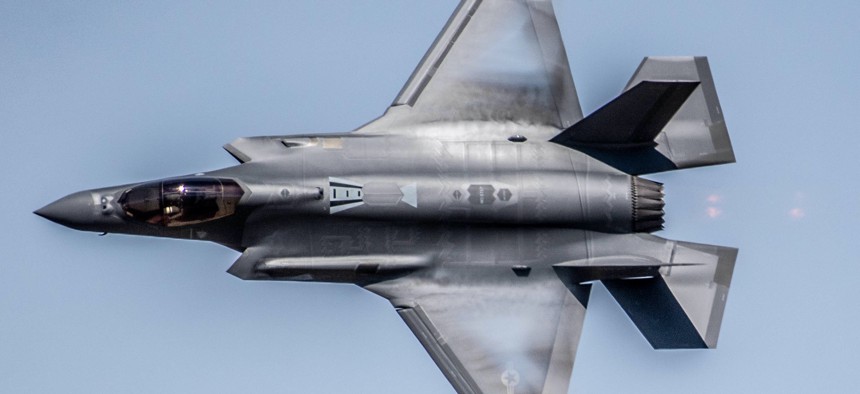
U.S. Air Force Maj. Kristin Wolfe performs a demonstration in the F-35A Lightning II during at the Reno Air Races in Reno, Nevada, September 19, 2021. U.S. Air Force / Tech. Sgt. Nicolas Myers
Defense Business Brief: Happy fiscal New Year; Lower F-35 production rates; Rolls-Royce wins B-52 re-engine contract and more.
Happy (fiscal) New Year!
The government has money, for now at least, thanks to an 11th-hour continuing resolution passed by Congress and signed by President Biden on Thursday, fiscal New Year’s Eve, if you will. This marks the 12th time in 13 years that Congress has been unable to pass a budget in time. A reminder: Spending is now frozen at fiscal 2021 levels, meaning the defense budget stays flat and the Pentagon cannot begin any new programs.
How did we get here? Well, it didn’t help that the Biden administration submitted its fiscal 2022 budget proposal to lawmakers on May 28, the latest any administration has ever done so.
Right now, lawmakers are trying to pass two spending bills: President Biden’s $1.2 trillion bipartisan infrastructure bill and a separate $3.5 trillion so-called social safety net bill. Progressive and moderate Democrats are at odds over the size of the latter bill.
Key dates: Oct. 18 is when the U.S. is expected to hit the debt ceiling, meaning it’s unable to pay its bills unless Congress raises the limit. Dec. 3 is when the continuing resolution expires.
There’s now a Covid-19 vaccine mandate for federal contractors and subcontractors. Workers must show proof of getting vaxxed by Dec. 8, our sister publication Government Executive reports. The full contractor guidance is here.
Raytheon Technologies has said it will require all its U.S. employees to get vaxxed, a company spokesman said in an emailed statement.
The U.S. military took a step forward in its hypersonic weapon development last week, successfully testing the Hypersonic Air-breathing Weapon Concept, or HAWC, which dropped from a jet and lit from its supersonic combustion ramjet. Raytheon and Northrop Grumman “are on track to deliver a prototype system to the U.S. Department of Defense,” the companies said.
The Australian government hired former Bush administration Navy Secretary Donald Winter to work on the Australia-U.K.-U.S. submarine pact reached earlier this month, according to LegiStorm.
Production of the F-35 Lightning II stealth fighter is now not expected to climb to the peak levels envisioned just a few years ago. Lockheed did not meet its F-35 delivery numbers last year due Covid-19-related disruptions, leading to this week’s production “rebalance.” The move “ensures predictability and stability in the production process while recovering the aircraft shortfall realized over the last year during the COVID-19 pandemic,” the company said in an emailed statement. This year, Lockheed Martin plans to deliver between 133 and 139 aircraft. That will climb to between 151 and 153 aircraft in 2022 and then156 in the years that follow. Production was originally expected to top out at 170 aircraft per year for the U.S. military and its allies. Lockheed has delivered more than 700 F-35s to the U.S. and allies.
Rolls-Royce North America scored the much-coveted $2.6 billion Air Force B-52 bomber re-engine contract, besting Pratt & Whitney and GE Aviation. It’s a major win for the U.S. arm of Rolls-Royce. The U.S. Air Force has 76 B-52s; each has eight engines, four on each wing. A version of the Rolls-Royce F130 engine that will be installed in B-52 is already used on Air Force C-37 Gulfstream transports and E-11 Bombardier communications planes.
Making Moves
The White House said President Biden plans to nominate Doug Bush to be the Army acquisition executive. The former long-time House Armed Services Committee staffer is the acting assistant Army secretary for acquisition, technology, and logistics.
James “Hondo” Geurts, the former head of Navy acquisition and acting undersecretary, has joined the Silicon Valley Defense Group’s advisory board. The non-partition, non-profit group “seeks to create the nexus of pioneering ideas, people, and capital that will unlock new sources of innovation for national security and power the digital evolution of the defense industrial base,” according to a statement from the group.
 From Defense One
From Defense One
Hypersonics Test Shows the US Is Catching Up in the New Missile Race // Patrick Tucker
But questions remain about costs and priorities remain.
Defense Business Board Relaunches After Pentagon Review // Marcus Weisgerber
Former Air Force Secretary Deborah Lee James named chair of the diverse advisory board.
Federal Contractors Must Show Proof of COVID-19 Vaccination by Dec. 8 // Courtney Bublé
Companies doing business with the federal government must name a person to coordinate implementation and compliance with the vaccine mandate for covered employees.
Air Force Chief Anticipates 'Something Special' for B-21 Public Debut // Tara Copp
The Raider is still on schedule to make its first test flight with the next year, Air Force chief says.
An Army Pilot Just Re-Invented Flight Training for the Digital Era // Patrick Tucker
By teaching an AI to read instruments with a camera, you get the best of the human and machine worlds.
Why Both Sides of the Atlantic Should Come Together on Tech // Lauren M. Speranza and Joanna van der Merwe
Insufficient coordination on investment priorities, integration, and governance has created space for Chinese and Russian gains.
AUKUS: Good Goals, Bad Implementation // Bradley Bowman and Mark Montgomery
Now begins the real work for the United States and its democratic allies: cooperating to strengthen their eroding deterrence in the Indo-Pacific.
US Navy's Latest Plan for Its Future May Not Come Until 2023, Says Top Admiral // Bradley Peniston
It's the fourth attempt in four years to define the future of the Navy.




